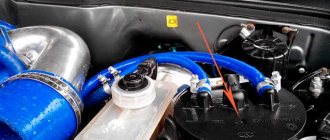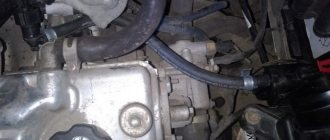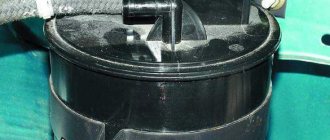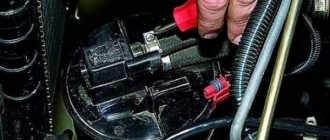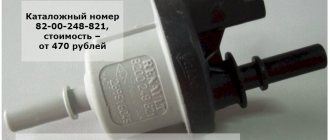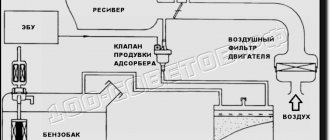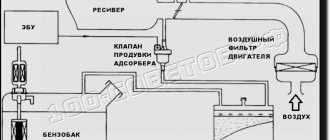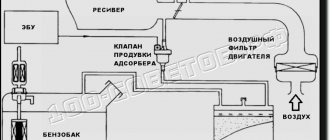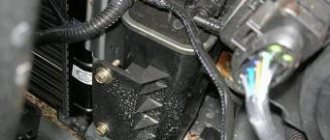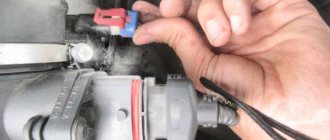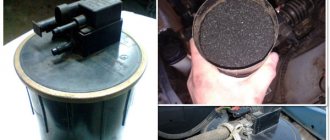As you know, the internal combustion engine of a car traditionally uses gasoline as the main type of fuel. Moreover, such a flammable and explosive petroleum product has an increased tendency to evaporate.
On the one hand, this is unsafe, and on the other hand, the result of the release of vapors is their release into the atmosphere and deterioration of the environment. So, to understand why an adsorber is needed in a car, it is worth noting that it is actually a filter for capturing gasoline vapors. This filter is installed in the ventilation system of the gas tank.
What is an adsorber in a car, why is it needed and where is it located?
Today, the European environmental standard “Euro-6” is in force, according to which the emission into the atmosphere of hydrocarbon vapors resulting from the combustion of fuel is prohibited. To implement this task, a special device was developed - an adsorber.
The name of the device comes from the word adsorbent (absorbent composition). The unit is mounted in the fuel system of a vehicle in order to absorb harmful vapors arising during the evaporation of fuel.
The absorbent is activated carbon, which fills the tank. It is this that absorbs harmful substances when the engine is not running. Otherwise, the vapors are sucked into the intake pipe and burned in the engine along with the combustible mixture.
This feature helps to increase the efficiency of the car. The result is a double effect: fewer harmful vapors enter the atmosphere and the combustible mixture is saved. Over time, the filter element becomes dirty and its effectiveness decreases.
The main sign of a malfunction is a “hissing” sound when the fuel tank cap is unscrewed. This happens due to the fact that fuel vapors have nowhere to go, and they “rush” out with all their might.
The location of the adsorber varies depending on the make and model of the car. So, in VAZ cars the device takes the form of a black can with a cylindrical shape. The device is often located on the right side in the direction of travel, in the near corner (near the headlight).
But for each model, the manufacturer determines the location of the device individually.
For example, in the VAZ 21099 the absorbent injector is located like this.
Classification of adsorbers
When the internal combustion engine received an injector and a catalyst, the power unit became more environmentally friendly, but environmental protection companies are constantly raising the acceptable bar, so both engines and their systems are constantly being improved. And the EVAP system is no exception. Today there are already several modifications of these devices.
Since their performance will not be affected by either the location of the adsorber or the length of the line, they differ from each other only in the filter material. The flask may contain:
- Fixed granular adsorbent;
- Mobile granular adsorbent;
- A fine-grained adsorbent that constantly boils from below.
Most automakers use the first modification. This is the easiest way to remove fuel vapors. The second and third options also effectively neutralize harmful substances, but in both cases, part of the adsorbent can be removed from the container along with the air into the environment. For this reason, routine vehicle maintenance, in addition to replacing lubricants and filters, also includes checking the level of the active substance. To do this, the flask is removed and, if necessary, an adsorbent is added.
From what Euro standards is it established?
According to international requirements, the installation of an adsorber is mandatory on cars with Euro-2 standards and higher. As for the standard known in Russia (Russia-83), there is no installation of an adsorber here.
So, in VAZ-2108 cars there is no adsorber. Here the separator and the fuel tank are connected to each other using a drain tube.
During operation, condensation occurs and returns to the fuel tank.
In addition, the separator interacts with the atmosphere using a 2-way valve, which does not allow the pressure in the tank to increase or decrease.
The connection between the tank and the neck occurs using a gasoline-resistant tube, fixed with clamps. It turns out that when the pressure in the tank decreases (increases), fuel vapors escape into the atmosphere.
The system is organized differently in VAZ Priora cars. Here, the fuel vapors that entered the separator from the fuel container condense. The condensate then accumulates and returns to the tank.
A gravity valve is mounted in the upper part of the separator, which prevents the fuel mixture from leaking out of the tank if the machine overturns.
If the engine is started, the vapors of the fuel mixture are mixed with air masses and discharged through the throttle assembly into the intake pipe - to the cylinders of the power unit.
It turns out that fuel vapors in a stationary position of the car accumulate in the adsorber, and if the car is moving, they are purged by the valve and sent to the receiver and to the engine for afterburning.
According to Euro-2 requirements, the fuel tank ventilation must not come into contact with ambient air, and vapors must be collected and directed to the engine (or adsorbed by the device in question).
As for the Russia-83 standards, contact between the atmosphere and ventilation of the fuel bank is not prohibited.
Why do you need an adsorber?
The first development of a car adsorber appeared as an additional system that increased the environmental friendliness of the car. Thanks to this device and the modernization of the power unit, the car could comply with the Euro2 eco-standard. This system itself is not needed for better engine performance. If you correctly adjust the gasoline injection , set the ignition and equip the car with a catalyst , the vehicle will comply with more stringent environmental standards.
This system was not used in carburetor engines. For this reason, there is always the smell of gasoline near an old car. If the vehicle is stored outside, it is hardly noticeable. But it is no longer possible to stay in a garage next to such a car for a long time without signs of gasoline vapor poisoning.
With the advent of injection internal combustion engines, the adsorber is an integral element of any car. The fact is that the environment is polluted not only by the removal of exhaust gases through the exhaust pipe. Gasoline vapors also enter the air, and even the highest quality engine with a modern exhaust gas purification system without this system for purifying vapors generated in the gas tank will not meet the high requirements of environmental protocols.
On the one hand, it would be possible to close the gas tank hermetically, and the problem is solved - the fumes do not enter the environment. However, this would not mean that gasoline would stop evaporating. As a result, the pressure in a sealed tank (especially during the hot season) will increase. This process is undesirable for the fuel system. For this reason, the tank must have ventilation.
It turns out to be a vicious circle: the tank cannot be closed hermetically so that gasoline vapors do not increase the pressure in it, but if ventilation is provided in it, these same vapors inevitably enter the atmosphere. The very purpose of the adsorber is to maintain the pressure in the tank at atmospheric level, but at the same time the environment is not polluted with harmful fumes.
In addition to environmental concerns, automakers have improved the safety of the vehicles themselves. The fact is that when the car is stored in a garage, without an adsorber, the air near it will be saturated with toxic fumes. Inevitably, this air enters the vehicle interior. Even with the windows open while driving, it will take time for these volatile substances to dissipate. Because of this, the driver, as well as all passengers, partially inhale polluted air and are poisoned.
The adsorber device, together with which devices it works
The device for absorbing harmful vapors of the fuel mixture consists of the following components:
- adsorbent composition (activated carbon);
- gravity (electromagnetic) valve;
- separator;
- purge valve;
- fuel drain pipes;
- steam hose.
The basis of the design is the adsorber, whose task is to collect harmful vapors that come from the fuel tank and prevent them from entering the atmosphere.
In this case, the adsorber will combine with:
- Fuel tank;
- Intake manifold;
- Atmosphere (through a separate valve installed on the air filter or at the inlet to the device).
The system valve is an actuator that combines the adsorber and the intake manifold.
Where is
On most cars it is located under the ignition coil, on the left side of the engine. To remove it, you need to remove the battery terminals, loosen and remove the mount, and remove all the hoses that are connected to it.
Locations of the adsorber in various brands of cars:
Principle of operation
Operating principle of the adsorber:
- When the car is stationary and the engine is turned off, excessive pressure of fuel vapor is formed in the fuel tank, which rises through the pipeline and is sent to the adsorber.
- The engine is running. The ECU (electronic control unit) of the machine, taking into account the current program and operating mode of the power unit, commands the solenoid valve to open.
- Fuel vapors accumulated in the adsorber are blown out through the vacuum that takes place in the intake manifold.
- Next, the vapors are sent to the intake manifold itself and to the combustion chamber. The result is obvious - the vapors burn out. As for the volume of vapor that enters the manifold, it depends on the opening time of the EM valve. The longer the path is open, the greater the volume of vapor available for combustion.
Motors equipped with a turbine have a compressor. The latter's task is to create a vacuum in the intake manifold.
That is why in special systems that provide vapor recovery on turbocharged engines, a 2-way valve is installed that operates and directs fuel vapor to the compressor inlet or into the intake manifold (in the presence or absence of pressure, respectively).
Diagram of the fuel vapor recovery system on Priora: design and designation of the main elements
The diagram of the gasoline vapor recovery system on Priora is as follows:
Fuel vapor recovery system VAZ-2170
In the diagram, each element has a corresponding name and purpose. The name of each item is listed in the description below:
The purpose of each element of the system is described in detail in the material below.
This is interesting! The vent tube numbered “9” is designed to remove air from the tank as it fills with fuel.
Pros and cons of the device
Like any other unit, the adsorber has its own positive and negative qualities that the car enthusiast should know about:
1. Advantages:
- No harmful fuel vapors enter the atmosphere.
- Fuel is saved because the vapors do not escape into the atmosphere, but return back to the engine for combustion.
- The unpleasant smell of gasoline disappears from the passenger compartment (this effect does not always occur).
2. Disadvantages:
- The adsorber has a substantial size, so it takes up a certain space under the hood.
- The engine operates unstably, and “swimming” occurs at idle (one of the main signs of a failed adsorber).
- High price. Installing an adsorber increases the cost of the car.
- Risk of the tank cap “shooting out”. This is possible in the event of a breakdown of the adsorber and prolonged accumulation of fuel gases in a confined space.
- Risk of deformation of the fuel pump. Ignoring the failure of the device also leads to this problem.
- Risk of accumulation of a flammable mixture in the intake manifold due to the inability of the adsorber to perform its functions. As a result, the stability of the motor is disrupted.
Malfunctions, inspection and repair
The ventilation system is very reliable, but problems occur here too. They are mainly associated with the aging of parts; the tightness of the lines, the housing may be compromised, or malfunctions in the operation of the purge valve may occur. In this case, both external signs of a malfunction of the adsorber are observed, as well as those noticed by the system from the inside, with the display of an error signal on the dashboard, memorizing its code and switching to emergency mode.
- As a rule, the first manifestation is unstable operation of the engine after warming up, when purging should begin, but for some reason this does not happen. Either additional air is sucked in, which leads to an increase in speed, since this air is not taken into account by the flow meter, or vice versa, the system assumes that the mixture is being released from the valve side into the manifold, but it is not there, the engine does not respond as expected.
- Changing the mixture composition will cause failures in engine operation, especially during the transition from idle to medium speed. These same violations lead to something that almost always accompanies problems with the power system - traction drops and consumption increases. Moreover, diagnosticians often forget about the adsorber and try to look for a problem elsewhere.
- To clarify the reasons, the control unit issues error codes; they are usually concentrated in the range from P0440 to P0455 . The scanning program will always decipher the codes and hint where to look for a fault.
The method for checking the adsorber is quite simple. First of all, you need to make sure that the housing is tight, creating a vacuum sequentially on each of the pipes, blocking the others. Then, clogging of the air hose is eliminated, which does not work under the best conditions due to dust and dirt, especially if it has been torn from its normal place.
The purge valve is checked using the same method, for vacuum. Typically valves are normally closed, meaning they should not allow air to pass through unless power is applied to it. Conversely, when there is a signal at the connector, the valve opens with a characteristic click. During normal operation in modulation mode, it should produce a clearly audible crackling sound. It is especially convenient to check the valve by connecting an adapter to the diagnostic connector under the control of a program that allows you to change the frequency of the control signal. Valves stuck in one position and soured, or that have lost their performance due to wear and contamination, may respond to single operations, but not operate at normal frequency. There is no point in repairing valves; they are inexpensive, and it is easier and more reliable to replace them with new ones.
The adsorber itself will cost a little more, especially if it is not a simple product from an unknown manufacturer, but a full-fledged device with the capabilities of the original. But it will have to be replaced; the tank ventilation system is so deeply integrated into the car’s power supply that introducing changes into it, all kinds of plugs and bypasses, can cost much more. It’s much safer to install new parts, replace the valve and hoses, and then forget about ventilation for a long time. In addition, everything related to the power supply system, that is, gasoline, has a high fire hazard; saving here is unacceptable. The destruction of the “left” adsorber, filled with concentrated vapors in the hot engine compartment, can destroy the car.
The answer to the question posed earlier, what is an adsorber in a car and why is it needed, can be further clarified in the application to a specific car. The designs differ significantly; perhaps some components in the review are not covered. But they are of secondary importance; the very physical principles underlying the environmental friendliness of storing fuel in a car are approximately the same for all cars.
Why do some motorists remove it?
Many car enthusiasts decide to remove a functional adsorber, considering it an unnecessary element in the car. At the same time, not all motorists can justify their actions.
Some drivers are sure that the presence of an adsorber leads to a decrease in the dynamics of the car, others - to an increase in the “gluttony” of the vehicle, and to others such a device seems completely unnecessary.
There is also a category of car enthusiasts who remove the device if it breaks and do not return the new element to its place. The reason is the high cost of the adsorber, which was mentioned above.
The work of discarding the adsorber (if you know some aspects) takes no more than 5 minutes. All that is required is to put a fine filter on the separator tube.
In this case, fuel vapors are directed into the atmosphere. In this case, the tube from the valve is closed, and the ECU program is adjusted. If you do not perform the last action, an error appears.
Knock in the transfer case of the new Chevrolet Niva. Direct from the factory
If leaks occur, replace damaged consumables. Domestic SUVs perform quite well on roads with different surfaces. But quite a lot of problems can arise with them. For example, a knock in the transfer case of the new Chevrolet Niva. This problem is not uncommon. Therefore, every owner of such a car should know the causes of this problem. Let's look at popular reasons When communicating with car owners, you can often hear the question of why the speed on the Chevrolet Niva does not drop.
Operating the engine in this mode is undesirable for any car model; high speeds not only have an unpleasant effect on the hearing, but also lead to increased fuel consumption. Such a problem can arise suddenly, everything seemed to be working perfectly, and then suddenly a high idle appeared. Many drivers, both experienced and beginners, are very puzzled by this problem.
Why the speed on the Chevrolet Niva does not reset will be discussed in this article. Let's analyze all known variants of such a problem and ways to solve it. Many car owners, after such a malfunction occurs, seek help from specialists, but in most cases the malfunction can be fixed with your own hands. We will tell you what needs to be done for this in this article for everyone interested in this issue. Why do you need a properly set idle speed?
When it comes to a car, the concept of idling can be attributed to the operation of the engine when the gear is off or when the clutch pedal is depressed. In such cases, the engine runs without load, that is, there is no transmission of torque from the power plant to the drive wheels.
For different engines, idle speed can range from to rpm. If their indicator is less than the recommended value, the engine will stop when the clutch pedal is pressed. An increase in their number, in addition to a significant increase in gasoline consumption, leads to accelerated wear of engine parts
This is why it is so important to keep their number within the recommended range.
Idle speed adjustment is carried out by several components and assemblies installed on the vehicle. These include an injector, a fuel pump, and various sensors, which can be mechanical or electronic. This also includes the throttle valve, fuel pressure regulator and some other devices. The number of revolutions is greatly influenced by the opening angle of the throttle valve, which regulates the amount of air entering the engine power system.
The idle air valve also takes part in mixture formation, which is needed to provide air supply bypassing the throttle valve. In some cases, an increase in their number may be caused by an incorrectly adjusted gas pedal drive. Why the speed doesn’t drop There are quite a lot of reasons for the appearance of such an unpleasant phenomenon, let’s try to understand this issue together and decide how to get out of this situation.
Most often, in injection engines, speed reduction does not occur due to the fault of the throttle assembly, in which contamination occurs.
Changing the device yourself
To change the adsorber, it is enough to perform a number of simple manipulations. In this case, there are two solutions - do the work yourself or go to a service station and entrust the problem to specialists.
The advantages of the first option are cost savings and high speed of work. The sequence of actions is as follows:
- Dismantle the old part, freeing it from the fixing elements and discarding the tube through which fuel vapors enter the throttle.
- Discard the block and wires.
- Connect the fuel outlet pipe from the separator and the purge valve.
- Remove the bracket by unscrewing the three bolts.
The work time is 15-20 minutes.
As soon as the faulty unit is dismantled, proceed with the installation of a new device.
Here the sequence is as follows:
- Connect a long piece of rubber tube to the hose through which fuel vapors flow into the purge channel.
- Connect the short part of the tube to the intake tube from the separator.
- Put the adsorber in place.
- Connect the vapor supply pipe to the purge channel, which is installed on the motor cover.
- Connect the block with wires.
- Install a tube between the purge channel and the adsorber. Make sure that the material from which the pipe is made is resistant to oil and gasoline.
Installing a new adsorber valve
If diagnostics of EVAP system performance must be performed by a specialist who understands graphical reports and required indicators, then replacing the canister valve is very simple. A new part must be selected not only by visual similarity. There are markings on the body of the device - it is according to these symbols that you need to select a new mechanism.
Replacement is carried out as follows. First you need to find where the valve is installed. The negative terminal is removed from the battery. This is necessary so that the on-board system does not record an error, which will then need to be reset, since in this case the ECU will go into emergency mode.
Next, the contact block with wires is disconnected. Usually there is a lock on it that prevents the wiring from being accidentally disconnected. The adsorber tubes are removed and the valve mount, if any, is unscrewed. Connecting the new part is done in the reverse order.
In addition, we offer a short video about how the adsorber works and how to check it:
Adsorber. Why is it needed, how does it work, how to check.
How to change only the valve?
There are situations when only the adsorber valve needs to be replaced. In this case, it is enough to spend 5-10 minutes of personal time to complete the entire range of work.
The valve is sold in any store, and its price (for VAZ cars) is only 600-1000 rubles.
At the same time as the valve, it is worth changing the adsorber sensor, because its functions include controlling the valve. Replacement is required if there are noises that resemble crackling.
It is necessary to begin work by diagnosing the serviceability of the valve. This is done as follows:
- Prepare a couple of wires and a multimeter.
- Release the retainer and remove the harness block from the purge valve.
- Connect the negative conductor of the multimeter to the ground of the car.
- Turn the key in the ignition and measure the voltage at output “A”. Normal voltage is 12 Volts. If it is not there, then there are two options - the ECU has failed or the battery is discharged.
- Loosen the clamp securing the tube to the valve and remove the hose from the pipe. Using a screwdriver, remove the valve from the adsorber, and then apply 12 Volts from the battery. The “positive” wire goes to terminal “A”, and the “negative” wire goes to “B”.
- As soon as voltage is applied to the connectors, the valve opens (a characteristic click is made). If this does not happen, then the valve is changed.
The valve is replaced according to the following algorithm (using the example of the VAZ-2114):
- Discard the “minus” from the battery;
- Discard the plug from the CPA;
- Release the inlet pipe clamp to gain access to the valve;
- Remove the device from the mass air flow sensor and move it to the side;
- Bend the valve clamps and dismantle the device;
- Move the mount to the side one centimeter;
- Pull the valve along the grooves;
- Discard the supply fittings. There may be problems with the second fitting, which has a special latch. To dismantle it, you need to tighten the special plastic antennae. This is easy to do - just recess the latch when the fitting is slightly raised up.
- Installation of a new device is carried out using the reverse algorithm.
How to disable or remove the adsorber on a car and do you need to reflash the ECU?
You need to understand that when the adsorber is removed, the solenoid valve is turned off, which is directly connected to the controller and controlled by the latter.
This will lead to error p0443, which we already mentioned above. The tubes are also silenced, in particular the one that goes to the intake manifold.
What is the disadvantage of such a shutdown?
The fact is that through the tube that goes to the intake manifold, air is constantly sucked in; even in idle mode, the so-called small purge of the adsorber occurs. At high speeds from 1500 – 2000 and above there is a lot of purging.
If you plug the pipe, which many people do, a certain amount of air will not flow into the intake manifold bypassing the ECU, but the latter still takes them into account.
That is, the controller takes into account one volume of air, but another (smaller) one actually enters. As a result, the amount of fuel is generated by the ECU based on more air than is supplied. This leads to an over-enrichment of the air-fuel mixture.
As a result, the engine does not work correctly, because the mixture is constantly over-enriched where it is and is not needed, and fuel consumption increases.
It is also worth talking about the transient mode of operation of the engine, which can manifest itself when approaching an intersection, a traffic light, lying to a policeman, at the moment when the gas is released.
At this moment, a failure may occur - a decrease in speed below idle. The engine seems to choke, it doesn’t have enough air, the reason is an over-enriched mixture. After a few seconds, the situation is resolved electronically.
Therefore, it would be correct to disable the adsorber in the following ways:
- After removing the device, install a nozzle with a diameter of 1 mm into the tube that goes directly past the mass air flow sensor. This will, at least partially, solve the problem, since only air without gasoline vapors will be supplied in doses.
- The ECU is re-queried (difficult). If it is impossible to remove the Check error, you may need engine chip tuning, which is expensive.
- Dismantling the entire system except the solenoid valve, which operates idle.
- By installing a resistor (valve emulation) in the electrical circuit at 200 - 250 Ohms and 2 watts. To do this, bend the legs of the resistor and insert them into the valve chip. We secure everything with electrical tape. But this doesn't always help.
How to disable the adsorber on a VAZ 2110, 2112, 2114
Taking into account the recommendations above, we do the following:
- Disconnect the power connector from the valve.
- Disconnect all pipes from the adsorber and remove the latter along with the mount.
- We fix the valve in a place where the plug with wires and pipes will reach.
- Connect a hose with a fuel filter to the lower fitting (see photo below).
- To the upper end fitting we connect the pipe going to the intake manifold.
- We put another filter on the pipe going into the tank, similar to the first one.
With this scheme, when the valve opens, clean air enters the system, albeit without gasoline vapors.
We exclude the valve
This method is even simpler. We dismantle everything, including the valve. We put a fuel filter on the pipe coming from the gas tank, and we plug the pipe going to the intake manifold with a bolt and clamp.
The consequences of this method are described above, but this method also has the right to life.
As for Priora, Granta, Lada Largus, Gazelle and other cars, the absorber is turned off in similar ways as described above.
Toyota Chaser
It is worth considering one of the foreign cars, for example, the Toyota Chaser.
The shutdown principle is similar to the previous ones:
- Locate the canister valve. It is located near the mass air flow sensor on the air filter housing.
- Disconnect the chip with wires and all pipes from it (Check may light up on the instrument panel).
- Find the adsorber, disconnect the pipes from it and plug it.
- Disconnect the pipe going to the valve from the throttle assembly and plug it with a bolt and clamp.
- Place a fuel filter from a carburetor VAZ on the pipe going to the tank.
What's the catch in flashing from Euro 4 to Euro 2?
Many people change the ECU from Euro-4 to Euro-2, as a rule, they do this when removing the catalyst and installing a blende. At this moment, the canister valve may turn off (on purpose or accidentally), and the ECU does not control the latter and does not control it in any way.
As a result, if the valve malfunctions, the engine will run intermittently, and the error will not be displayed on the instrument panel. To make sure of this, turn off the valve and observe the operation of the motor.
If the version is confirmed, plug the canister pipes and turn off the valve; the controller still does not control it.
